Chanwoo Park
Post-Training LLMs as Better Decision-Making Agents: A Regret-Minimization Approach
Nov 06, 2025Abstract:Large language models (LLMs) are increasingly deployed as "agents" for decision-making (DM) in interactive and dynamic environments. Yet, since they were not originally designed for DM, recent studies show that LLMs can struggle even in basic online DM problems, failing to achieve low regret or an effective exploration-exploitation tradeoff. To address this, we introduce Iterative Regret-Minimization Fine-Tuning (Iterative RMFT), a post-training procedure that repeatedly distills low-regret decision trajectories back into the base model. At each iteration, the model rolls out multiple decision trajectories, selects the k-lowest regret ones, and fine-tunes itself on them. Unlike prior methods that (a) distill action sequences from known DM algorithms or (b) rely on manually crafted chain-of-thought templates, our approach leverages the regret metric to elicit the model's own DM ability and reasoning rationales. This reliance on model-generated reasoning avoids rigid output engineering and provides more flexible, natural-language training signals. Empirical results show that Iterative RMFT improves LLMs' DM performance across diverse models - from Transformers with numerical input/output, to open-weight LLMs, and advanced closed-weight models like GPT-4o mini. Its flexibility in output and reasoning formats enables generalization across tasks with varying horizons, action spaces, reward processes, and natural-language contexts. Finally, we provide theoretical insight showing that a single-layer Transformer under this paradigm can act as a no-regret learner in a simplified setting. Overall, Iterative RMFT offers a principled and general post-training framework for enhancing LLMs' decision-making capabilities.
Thunder-Tok: Minimizing Tokens per Word in Tokenizing Korean Texts for Generative Language Models
Jun 18, 2025Abstract:This paper introduces Thunder-Tok, a new Korean tokenizer designed to reduce token fertility without compromising model performance. Our approach uses a rule-based pre-tokenization method that aligns with the linguistic structure of the Korean language. We also create a seed vocabulary containing tokens that resemble linguistic units and employ a branching entropy-based selection algorithm. These techniques increase the average token length, thus lowering fertility while preserving linguistic information. Experimental results indicate that Thunder-Tok reduces fertility by approximately 10% (i.e., reduces the number of tokens by 10%, improving the inference speed by 10%) compared to BPE without compromising performance across various downstream tasks. These findings demonstrate that our linguistically informed approach is effective and practical for designing efficient tokenizers for language models.
Tiered Agentic Oversight: A Hierarchical Multi-Agent System for AI Safety in Healthcare
Jun 14, 2025Abstract:Current large language models (LLMs), despite their power, can introduce safety risks in clinical settings due to limitations such as poor error detection and single point of failure. To address this, we propose Tiered Agentic Oversight (TAO), a hierarchical multi-agent framework that enhances AI safety through layered, automated supervision. Inspired by clinical hierarchies (e.g., nurse, physician, specialist), TAO conducts agent routing based on task complexity and agent roles. Leveraging automated inter- and intra-tier collaboration and role-playing, TAO creates a robust safety framework. Ablation studies reveal that TAO's superior performance is driven by its adaptive tiered architecture, which improves safety by over 3.2% compared to static single-tier configurations; the critical role of its lower tiers, particularly tier 1, whose removal most significantly impacts safety; and the strategic assignment of more advanced LLM to these initial tiers, which boosts performance by over 2% compared to less optimal allocations while achieving near-peak safety efficiently. These mechanisms enable TAO to outperform single-agent and multi-agent frameworks in 4 out of 5 healthcare safety benchmarks, showing up to an 8.2% improvement over the next-best methods in these evaluations. Finally, we validate TAO via an auxiliary clinician-in-the-loop study where integrating expert feedback improved TAO's accuracy in medical triage from 40% to 60%.
BehaviorSFT: Behavioral Token Conditioning for Clinical Agents Across the Proactivity Spectrum
May 27, 2025Abstract:Large Language Models (LLMs) as clinical agents require careful behavioral adaptation. While adept at reactive tasks (e.g., diagnosis reasoning), LLMs often struggle with proactive engagement, like unprompted identification of critical missing information or risks. We introduce BehaviorBench, a comprehensive dataset to evaluate agent behaviors across a clinical assistance spectrum, ranging from reactive query responses to proactive interventions (e.g., clarifying ambiguities, flagging overlooked critical data). Our BehaviorBench experiments reveal LLMs' inconsistent proactivity. To address this, we propose BehaviorSFT, a novel training strategy using behavioral tokens to explicitly condition LLMs for dynamic behavioral selection along this spectrum. BehaviorSFT boosts performance, achieving up to 97.3% overall Macro F1 on BehaviorBench and improving proactive task scores (e.g., from 95.0% to 96.5% for Qwen2.5-7B-Ins). Crucially, blind clinician evaluations confirmed BehaviorSFT-trained agents exhibit more realistic clinical behavior, striking a superior balance between helpful proactivity (e.g., timely, relevant suggestions) and necessary restraint (e.g., avoiding over-intervention) versus standard fine-tuning or explicit instructed agents.
Toward Evaluative Thinking: Meta Policy Optimization with Evolving Reward Models
Apr 28, 2025Abstract:Reward-based alignment methods for large language models (LLMs) face two key limitations: vulnerability to reward hacking, where models exploit flaws in the reward signal; and reliance on brittle, labor-intensive prompt engineering when LLMs are used as reward models. We introduce Meta Policy Optimization (MPO), a framework that addresses these challenges by integrating a meta-reward model that dynamically refines the reward model's prompt throughout training. In MPO, the meta-reward model monitors the evolving training context and continuously adjusts the reward model's prompt to maintain high alignment, providing an adaptive reward signal that resists exploitation by the policy. This meta-learning approach promotes a more stable policy optimization, and greatly reduces the need for manual reward prompt design. It yields performance on par with or better than models guided by extensively hand-crafted reward prompts. Furthermore, we show that MPO maintains its effectiveness across diverse tasks, such as question answering and mathematical reasoning, without requiring specialized reward designs. Beyond standard RLAIF, MPO's meta-learning formulation is readily extensible to higher-level alignment frameworks. Overall, this method addresses theoretical and practical challenges in reward-based RL alignment for LLMs, paving the way for more robust and adaptable alignment strategies. The code and models will be publicly shared.
MAPoRL: Multi-Agent Post-Co-Training for Collaborative Large Language Models with Reinforcement Learning
Feb 25, 2025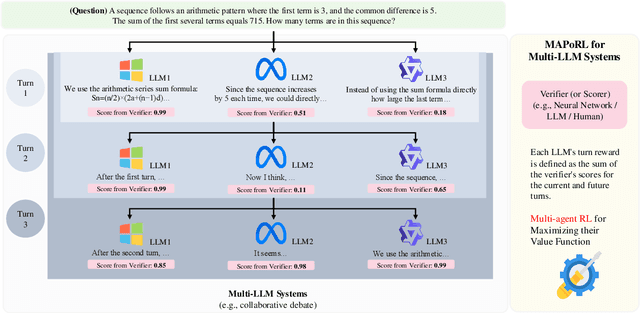
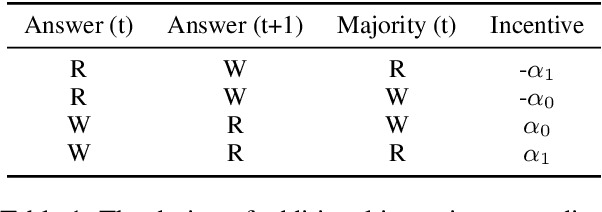

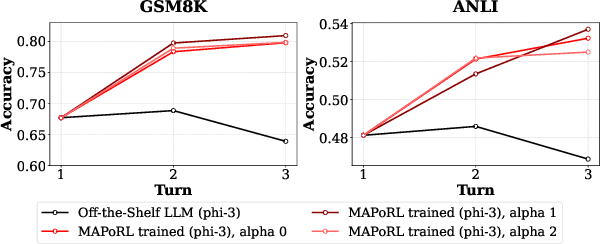
Abstract:Leveraging multiple large language models (LLMs) to build collaborative multi-agentic workflows has demonstrated significant potential. However, most previous studies focus on prompting the out-of-the-box LLMs, relying on their innate capability for collaboration, which may not improve LLMs' performance as shown recently. In this paper, we introduce a new post-training paradigm MAPoRL (Multi-Agent Post-co-training for collaborative LLMs with Reinforcement Learning), to explicitly elicit the collaborative behaviors and further unleash the power of multi-agentic LLM frameworks. In MAPoRL, multiple LLMs first generate their own responses independently and engage in a multi-turn discussion to collaboratively improve the final answer. In the end, a MAPoRL verifier evaluates both the answer and the discussion, by assigning a score that verifies the correctness of the answer, while adding incentives to encourage corrective and persuasive discussions. The score serves as the co-training reward, and is then maximized through multi-agent RL. Unlike existing LLM post-training paradigms, MAPoRL advocates the co-training of multiple LLMs together using RL for better generalization. Accompanied by analytical insights, our experiments demonstrate that training individual LLMs alone is insufficient to induce effective collaboration. In contrast, multi-agent co-training can boost the collaboration performance across benchmarks, with generalization to unseen domains.
Integrating Spatial and Frequency Information for Under-Display Camera Image Restoration
Jan 30, 2025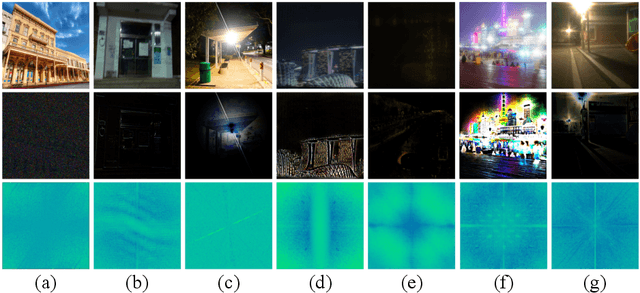
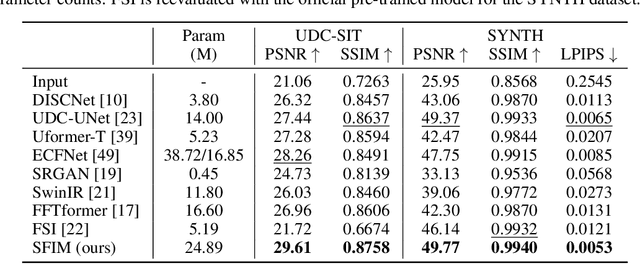
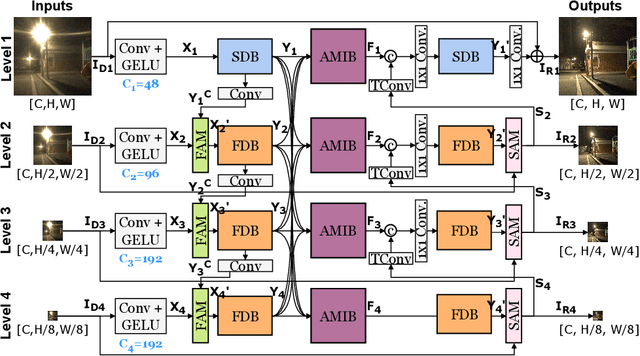
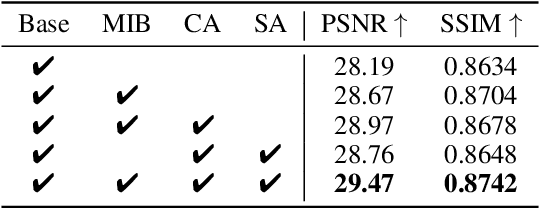
Abstract:Under-Display Camera (UDC) houses a digital camera lens under a display panel. However, UDC introduces complex degradations such as noise, blur, decrease in transmittance, and flare. Despite the remarkable progress, previous research on UDC mainly focuses on eliminating diffraction in the spatial domain and rarely explores its potential in the frequency domain. It is essential to consider both the spatial and frequency domains effectively. For example, degradations, such as noise and blur, can be addressed by local information (e.g., CNN kernels in the spatial domain). At the same time, tackling flares may require leveraging global information (e.g., the frequency domain). In this paper, we revisit the UDC degradations in the Fourier space and figure out intrinsic frequency priors that imply the presence of the flares. Based on this observation, we propose a novel multi-level DNN architecture called SFIM. It efficiently restores UDC-distorted images by integrating local and global (the collective contribution of all points in the image) information. The architecture exploits CNNs to capture local information and FFT-based models to capture global information. SFIM comprises a spatial domain block (SDB), a Frequency Domain Block (FDB), and an Attention-based Multi-level Integration Block (AMIB). Specifically, SDB focuses more on detailed textures such as noise and blur, FDB emphasizes irregular texture loss in extensive areas such as flare, and AMIB enables effective cross-domain interaction. SFIM's superior performance over state-of-the-art approaches is demonstrated through rigorous quantitative and qualitative assessments across three UDC benchmarks.
UDC-VIT: A Real-World Video Dataset for Under-Display Cameras
Jan 30, 2025



Abstract:Under Display Camera (UDC) is an advanced imaging system that places a digital camera lens underneath a display panel, effectively concealing the camera. However, the display panel significantly degrades captured images or videos, introducing low transmittance, blur, noise, and flare issues. Tackling such issues is challenging because of the complex degradation of UDCs, including diverse flare patterns. Despite extensive research on UDC images and their restoration models, studies on videos have yet to be significantly explored. While two UDC video datasets exist, they primarily focus on unrealistic or synthetic UDC degradation rather than real-world UDC degradation. In this paper, we propose a real-world UDC video dataset called UDC-VIT. Unlike existing datasets, only UDC-VIT exclusively includes human motions that target facial recognition. We propose a video-capturing system to simultaneously acquire non-degraded and UDC-degraded videos of the same scene. Then, we align a pair of captured videos frame by frame, using discrete Fourier transform (DFT). We compare UDC-VIT with six representative UDC still image datasets and two existing UDC video datasets. Using six deep-learning models, we compare UDC-VIT and an existing synthetic UDC video dataset. The results indicate the ineffectiveness of models trained on earlier synthetic UDC video datasets, as they do not reflect the actual characteristics of UDC-degraded videos. We also demonstrate the importance of effective UDC restoration by evaluating face recognition accuracy concerning PSNR, SSIM, and LPIPS scores. UDC-VIT enables further exploration in the UDC video restoration and offers better insights into the challenge. UDC-VIT is available at our project site.
A Demonstration of Adaptive Collaboration of Large Language Models for Medical Decision-Making
Oct 31, 2024



Abstract:Medical Decision-Making (MDM) is a multi-faceted process that requires clinicians to assess complex multi-modal patient data patient, often collaboratively. Large Language Models (LLMs) promise to streamline this process by synthesizing vast medical knowledge and multi-modal health data. However, single-agent are often ill-suited for nuanced medical contexts requiring adaptable, collaborative problem-solving. Our MDAgents addresses this need by dynamically assigning collaboration structures to LLMs based on task complexity, mimicking real-world clinical collaboration and decision-making. This framework improves diagnostic accuracy and supports adaptive responses in complex, real-world medical scenarios, making it a valuable tool for clinicians in various healthcare settings, and at the same time, being more efficient in terms of computing cost than static multi-agent decision making methods.
Principled RLHF from Heterogeneous Feedback via Personalization and Preference Aggregation
Apr 30, 2024
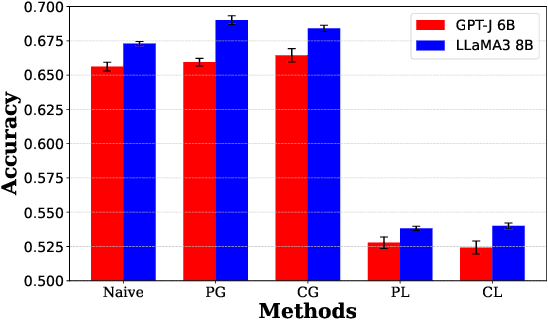
Abstract:Reinforcement learning from human feedback (RLHF) has been an effective technique for aligning AI systems with human values, with remarkable successes in fine-tuning large-language models recently. Most existing RLHF paradigms make the underlying assumption that human preferences are relatively homogeneous, and can be encoded by a single reward model. In this paper, we focus on addressing the issues due to the inherent heterogeneity in human preferences, as well as their potential strategic behavior in providing feedback. Specifically, we propose two frameworks to address heterogeneous human feedback in principled ways: personalization-based one and aggregation-based one. For the former, we propose two approaches based on representation learning and clustering, respectively, for learning multiple reward models that trades off the bias (due to preference heterogeneity) and variance (due to the use of fewer data for learning each model by personalization). We then establish sample complexity guarantees for both approaches. For the latter, we aim to adhere to the single-model framework, as already deployed in the current RLHF paradigm, by carefully aggregating diverse and truthful preferences from humans. We propose two approaches based on reward and preference aggregation, respectively: the former utilizes both utilitarianism and Leximin approaches to aggregate individual reward models, with sample complexity guarantees; the latter directly aggregates the human feedback in the form of probabilistic opinions. Under the probabilistic-opinion-feedback model, we also develop an approach to handle strategic human labelers who may bias and manipulate the aggregated preferences with untruthful feedback. Based on the ideas in mechanism design, our approach ensures truthful preference reporting, with the induced aggregation rule maximizing social welfare functions.
 Add to Chrome
Add to Chrome Add to Firefox
Add to Firefox Add to Edge
Add to Edge